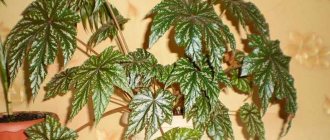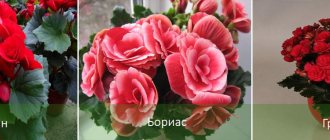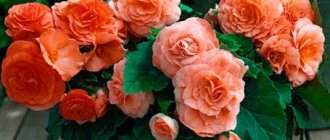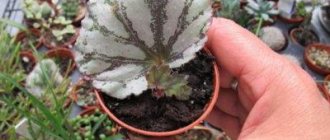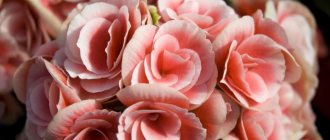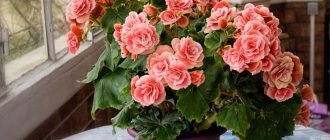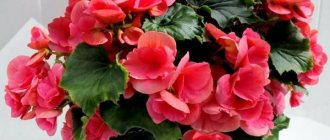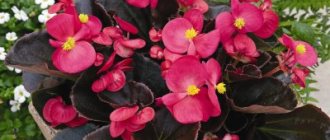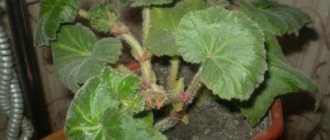Caring for decorative deciduous begonias at home
Landing
It is advisable to carry out all manipulations with the plant in early spring , when it is just beginning to grow. The fact is that planting and replanting slow down development for some time, because begonia experiences stress from changed conditions. It is important to take this into account when bringing a new plant from the store to your home or office. Store-bought begonia was grown in greenhouse conditions in compliance with all the rules, but at home it is forced to adapt in a new way.
Priming
The soil used is slightly acidic or closer to neutral . It should be loose and fertile. Leaf soil and humus are taken and pre-disinfected. Sand is added to this mixture. It is also recommended to add perlite or vermiculite to improve the quality of the soil.
Pot
The container for deciduous begonias is wide, but not deep. Plastic pots work well ; it is easy to remove the plant from them when the need for replanting arises. Holes must be made at the bottom of the pot - this provides additional air access to the roots and the outflow of excess water.
Watering
For irrigation, water is settled or boiled. Water only when the top layer of soil is dry. Experts also determine the need for watering by changes in the weight of the pot. You can gradually pour water from the pan until the top layer darkens.
In summer a frequent supply of moisture is required, in winter less often and always after the top layer of soil has dried to a depth of at least 1 cm.
Do not allow excess moisture; it is better to water begonia less.
Air humidity
Prefers moderate humidity. If the air is too dry, there is a high probability of spider mites appearing, and if the humidity is high, there is a risk of rotting roots and leaves. It is not recommended to spray begonia. To increase air humidity, containers with water are placed next to the pot or the begonia is placed on a wide tray into which moistened expanded clay is poured.
Temperature
Prefers moderate temperatures from 18 to 25 degrees. It is not advisable to place the plant next to cold drafts and radiators. In summer they are placed in a cool place.
Location
Begonia loves light, but it must be diffused. Bright sun will burn the leaves and make them pale or increase the amount of green pigment, reducing the variegation. Lack of lighting will affect growth and reduce the variegation of foliage.
Begonias do not like sudden changes in location, however, in order for the foliage to grow evenly, the plant can be slowly rotated relative to the light source.
Planting and growing
It is advisable to plant decorative deciduous begonias in early spring. Begonia is a plant that is stressed by any planting or transplanting. Because of this, the development of the bush slows down. Carry out the planting process slowly and not in a heavily lit room. You need to be especially careful in a situation where you bring begonia from the store to the office. Before you purchased the begonia, it was grown in greenhouse conditions, but now it needs to get used to new, completely different conditions.
Reproduction
Most types of domestic begonias are easy to propagate. Take a small cutting about 5 cm long and place it in a glass of clean water. The best time for this is spring. Instead of cuttings, leaves are used, they are cut with a sharp knife, and the sections are disinfected with charcoal. Reproduction is also possible in parts of the leaf blade, cutting it so that the central vein remains on each piece. After this, the pieces are laid on loose soil, sand or perlite, pressed against them, and covered with a bag or jar on top.
After rooting, cuttings are planted in small pots or plastic cups. You cannot immediately plant it in a large container - the soil in such a pot takes a long time to dry out, which can lead to the death of a young specimen.
Transfer
Every spring, the soil is renewed and the plant is replanted. If it has grown greatly and the roots have become crowded, then take a pot a little wider than before. A layer of drainage is poured onto the bottom , for which expanded clay or brick chips are taken. The roots are cleared of old soil, the plant is placed in a new pot and carefully sprinkled with soil, sometimes tapping the pot so that the soil lies evenly. After this, the begonia must be watered, and excess water is removed from the pan.
Popular types of home begonias
- Decorative deciduous. The peculiarity of this species lies in the root, or more precisely, the flower does not have a common stem. Leaf blades begin to grow from the root. They come in different varieties: with red or silver foliage, multi-colored or speckled. The most popular among them are: tiger, rex, tiara, etc. For example, to avoid searching for the causes of the problem of why coral begonia does not bloom, you should know that it needs to be protected from direct sunlight and watered frequently in the summer.
- Decorative blooming. This species is distinguished by large flowers (up to 30 cm in diameter); narrow leaves, which are also elongated and small in size; the buds bloom both individually and in clusters. In winter it goes into a dormant state. The most popular: Slender, Elatior, Tuberous, Everblooming, etc.
Features of care in winter
In winter, most plants go into a dormant period. Watering is reduced.
The amount of light decreases in winter, so begonia is placed closer to the window or artificial lighting is added.
Protect the plant from exposure to cold air and radiators. Carefully monitor the watering regime, its excess will lead to rotting of the root system.
Also read on our website about the following varieties of begonia: Red-leaved, Bauer, Masona, Hogweed, Cleopatra, Royal, Spotted, Vorotnichkovaya.
Silver Star
A herbaceous plant reaching a height of 25-30 cm. The shrub has large, spectacular oval-shaped leaves with a pointed apex. The surface is lumpy due to small papillae located on it. The color is rich olive with light green veins, along which there are silvery areas that occupy most of the surface.
Diseases and pests
Too humid air and excess watering in winter will lead to the appearance of powdery mildew: plaque appears on the leaves and they die.
When the air is dry, the edges of the leaves dry out and turn brown. With a lack of lighting, the leaves stretch out, become small and pale.
In the summer, begonia may be attacked by aphids, which were accidentally brought in from the street. Spider mites are also likely to appear - they love dry air. To remove pests, use the drug Actellik, which is sprayed on the plant.
Begonia is an almost ideal plant to keep at home or in the office. It looks great in green corners and winter gardens.
Decorative leaf begonia purifies indoor air and helps fight dangerous bacteria.
Temperature and light conditions
Begonia is native to South Africa, hence its love of bright light, especially during the flowering period. However, you should not leave the plant under the scorching sun all the time - this can lead to damage to the leaves. Decorative deciduous varieties are best left under diffused lighting on window sills on the western or eastern side of the house.
Just like good light, begonia prefers warmth. The temperature is comfortable for her: in summer – 22-23 degrees, in winter – 15-17.
Photo
Below you will see photos on how to care for decorative deciduous begonias at home:
Possible problems and care errors
Begonia, like any flower, gets sick mainly due to errors in care. How to grow healthy begonia - let's name some mistakes and ways to solve them.
Begonia doesn't bloom
Usually the reason is an incorrectly selected fertilizer. If it is nitrogenous, then the process of bud formation will naturally be greatly inhibited. This type of fertilizer is suitable for deciduous types.
Begonia Bauer.
Another option is the wrong place for the plant, or the wrong temperature. The solution is to move the flower to another location and change the type of feeding.
Flower buds fall
The plant is experiencing stress. This usually happens in three cases:
- Excessive soil moisture.
- Wrong place.
- Excess fertilizer.
The solution is to find the cause and eliminate it.
Leaves turn yellow and curl
Sick begonia.
This is a symptom of soil depletion or drying out. Perhaps pests have appeared in the roots; to do this, they can be rinsed in a solution of potassium permanganate. Leaves turn black from excess moisture. The fragility of the plant indicates a lack of moisture or nutrition. Pale – lack of light. If the flower stretches upward, then it does not have enough sun, it spreads or crumbles to the sides - it is too dry.
Rot in the soil or at the base of the flower
This is one of the manifestations of a serious problem - pests have infested the roots and soil. This problem usually occurs if the plant is over-watered. Leaves with plaque must be moistened and the soil must be completely replaced. The flower must be treated with a fungicide. Other parasites include aphids and mites. In this case, begonia is treated with corocidal and insecticidal preparations.
When does flowering occur and how long does this period last?
Blooming begonia cannot go unnoticed due to the large number of inflorescences. The most common types of this plant bloom on average from May to November, but in general the duration and time of flowering depend on:
- Plant varieties. Terry large-flowered species bloom less than others.
- Growing method. In open ground, the flowering period is limited due to weather conditions and the need to transplant indoors. At the same time, there are species that, after transplanting into a pot, bloom until spring.
- Care. It is necessary to create comfortable conditions and provide proper care, otherwise flowering will be short-lived or not at all.
- Time to wake up. If you start awakening the plant from dormancy at the end of February, flowers will appear in April-May.
- Type of root system. Begonia with a tuberous root system blooms in the summer-autumn period, with a regular one - almost all year round.
Reference! It is possible to extend the period and increase the intensity of begonia flowering by removing the female flowers from the formation itself, but it will be impossible to obtain seeds.
Origin and characteristics of begonia
The genus Begonia of the Begoniaceae family is numerous and diverse. These are plants that live in West Africa, the tropics and subtropics of South America, Southeast Asia, and Indochina. The most attractive begonias came to Europe at the end of the 17th century thanks to the enthusiasm of the French naturalist Charles Plumier. The name of the genus and family was given in honor of Michel Begon, the organizer and sponsor of the scientific expedition.
One of the plants found with magnificent leaves was given the name Royal Begonia or rex.
Later, large-flowered begonias were discovered in Bolivia, Peru, and Brazil, from which the now popular hybrids were bred.
Description of the features of begonia:
- Life forms - grasses, vines, using tree-like plants as support; subshrubs, shrubs, epiphytes.
- Leaf begonias have attractive leaves that are large, velvety or smooth, with patterns of silver, pink, burgundy and green.
- Asymmetrical leaf shape, heterosexual flowers, fixed in inflorescences with an umbrella or brush.
- Flower corollas are simple or double. Color: red, pink, orange, white, yellow. Shades and transitions between these colors (there are no blues or light blues).
- Flowering continues for a long time, in many species - all year.
Perennial begonias are common in indoor culture, while annuals are common in garden culture. Flower growers have plenty to choose from: everyone, if desired, will find species, varieties or varieties that will fit better into the interior of an apartment or office.

